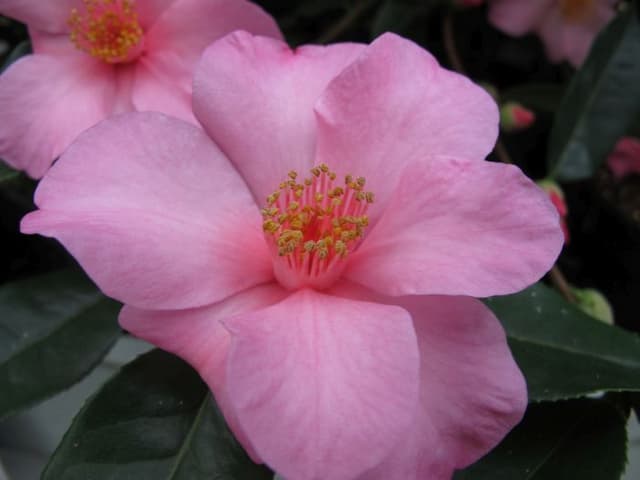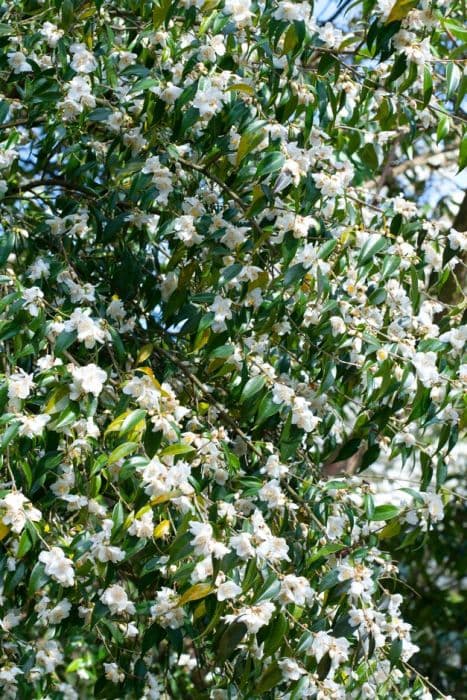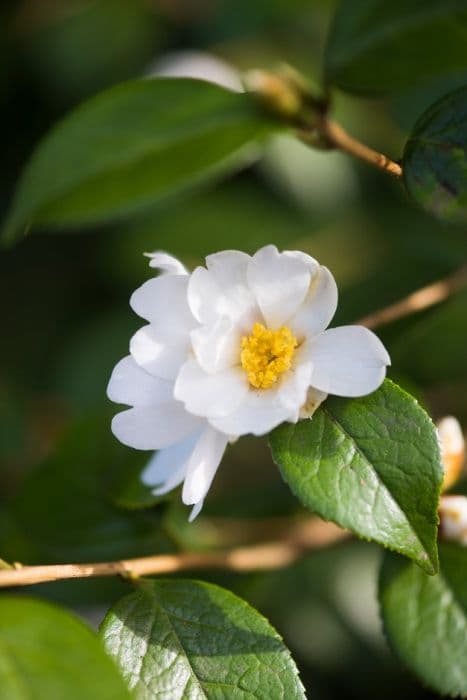Sasanqua Camellia Camellia sasanqua 'Jean May'

ABOUT
The 'Jean May' camellia is a flowering shrub that captivates the eye with its delicate elegance. Renowned for its lush foliage, the plant boasts glossy, dark green leaves that elegantly frame the blooms. These leaves create a dense and layered canopy that serves as a perfect backdrop for the flowers. During blooming season, 'Jean May' comes alive with an abundance of stunning flowers. The blooms exhibit a charming pink hue that can range from soft pastel to a more vivid pink tone depending on the variety. Each flower embodies a classic camellia form - full and rounded - with petals that are slightly ruffled and overlapping. These petals are arranged in a symmetrical pattern around a central cluster of contrasting yellow stamens, which stand out brilliantly against the pink petals. The overall beauty of the 'Jean May' camellia lies in its elegant form and the blend of colors between the dark green of the leaves and the alluring pink of the flowers. When in full bloom, the shrub radiates a romantic aesthetic that is often associated with traditional ornamental gardens. The display of blooms typically happens in the fall and early winter, providing a splash of color during a time when many other plants have ceased to flower. In summary, the 'Jean May' camellia is a picturesque plant that charms with its vibrant pink flowers, glossy green foliage, and well-proportioned, attractive form. It's a classic choice for gardeners looking to add a touch of elegance and year-round interest to their garden spaces.
About this plant
 Names
NamesSynonyms
Sasanqua Camellia, Christmas Camellia, Autumn Camellia, Winter Camellia.
Common names
Camellia sasanqua 'Jean May'.
 Toxicity
ToxicityTo humans
Sasanqua camellia is not considered toxic to humans. Therefore, ingesting parts of this plant typically does not lead to poisoning or adverse health effects in humans.
To pets
Sasanqua camellia is generally considered non-toxic to pets as well. Accidental ingestion of this plant by dogs, cats, or other animals is not expected to cause significant symptoms of poisoning. However, it is always best to prevent pets from eating plants as individual animals might have sensitivities or allergic reactions.
 Characteristics
CharacteristicsLife cycle
Perennials
Foliage type
Evergreen
Color of leaves
Green
Flower color
Pink
Height
4-5 feet [1.2-1.5 meters]
Spread
5-7 feet [1.5-2.1 meters]
Plant type
Shrub
Hardiness zones
7
Native area
Japan
Benefits
 General Benefits
General Benefits- Ornamental Value: Produces delicate pink, semi-double to double blooms that enhance garden aesthetics.
- Evergreen Foliage: Offers year-round greenery, adding consistent color and texture to landscapes.
- Drought Tolerance: Once established, it can withstand periods of low water, ideal for drought-prone regions.
- Cold Hardiness: Capable of surviving in cooler temperatures, making it suitable for a range of climates.
- Low Maintenance: Generally requires minimal care, such as occasional pruning and infrequent feeding.
- Wildlife Attraction: Flowers can attract pollinators such as bees and butterflies, promoting biodiversity.
- Versatility in Landscaping: Suitable for use in hedges, screens, foundation plantings, or as a specimen plant.
- Long Blooming Season: Offers extended flowering from fall to winter, providing color when many plants are dormant.
- Shade Tolerance: Can grow in partial shade, offering flexibility in garden placement and design.
- Privacy Screen: Dense growth habit can provide privacy when planted in rows or as a hedge.
 Medical Properties
Medical PropertiesThis plant is not used for medical purposes.
 Air-purifying Qualities
Air-purifying QualitiesThis plant is not specifically known for air purifying qualities.
 Other Uses
Other Uses- Privacy Screening: Camellia sasanqua 'Jean May' can be planted in a row to create a dense, evergreen privacy screen for your garden or property boundary.
- Topiary Art: Due to its dense growth habit, 'Jean May' can be pruned and trained into various shapes and forms, making it suitable for topiary art.
- Windbreak: The thick foliage of 'Jean May' makes it an excellent choice for a windbreak, helping to protect more sensitive plants in your garden.
- Bonsai: Camellia sasanqua varieties are often used for bonsai due to their attractive foliage and flowers, and 'Jean May' is no exception.
- Container Planting: 'Jean May' can be grown in containers on patios or balconies, bringing evergreen beauty to small outdoor spaces.
- Culinary Garnish: The petals of 'Jean May' can be used as an edible garnish for salads and desserts, adding a splash of color and elegance.
- Natural Dye: The flowers of 'Jean May' can be used to produce natural dyes for fabrics or crafts, though this is not commonly practiced.
- Erosion Control: Planting 'Jean May' on slopes can help prevent soil erosion due to its root system and foliage cover.
- Wedding Decor: The flowers of 'Jean May' could be used in floral arrangements or as venue decor for weddings, offering a touch of natural beauty.
- Pot-pourri: Dried 'Jean May' petals can be included in homemade pot-pourri mixtures to add fragrance to indoor spaces.
Interesting Facts
 Feng Shui
Feng ShuiThe Sasanqua Camellia is not used in Feng Shui practice.
 Zodiac Sign Compitability
Zodiac Sign CompitabilityThe Sasanqua Camellia is not used in astrology practice.
 Plant Symbolism
Plant Symbolism- Admiration: Camellia sasanqua 'Jean May' can represent deep admiration for someone’s beauty and spirit, often given to express personal regard.
- Love: This variety of camellia can symbolize a romantic, passionate form of love, signifying desire and passion in a relationship.
- Perfection: With its perfectly formed petals and lush appearance, the plant often stands for the idea of perfection and excellence.
- Affection: The gift of a camellia is traditionally seen as an act of affection, suggesting a connection between the giver and the receiver.
- Longevity: In many cultures, camellias symbolize long life and faithfulness, reflecting the long blooming season and the plant's hardiness.
 Water
WaterSasanqua camellias, including 'Jean May', should be watered regularly to maintain moist but not soggy soil. They typically require watering once or twice a week, depending on weather conditions and soil drainage. During hot and dry periods, increase watering frequency to prevent drought stress. Each watering session should provide enough water to moisten the soil to a depth of at least 6 to 8 inches, which usually translates to about 1 to 1.5 gallons for smaller shrubs and more for larger specimens. It's important to reduce watering during the winter months when the plant is not actively growing.
 Light
LightSasanqua camellias prefer bright, filtered light or partial shade to thrive. They should be placed in a location where they are shielded from the intense afternoon sun, especially in hotter climates. A spot with morning sunlight and afternoon shade is ideal to ensure the plant receives sufficient light without being subjected to harsh conditions that can cause leaf scorch.
 Temperature
TemperatureSasanqua camellias are hardy in temperate climates and can tolerate temperatures as low as 10 degrees Fahrenheit without significant damage. However, they grow best in temperatures ranging from 50 to 70 degrees Fahrenheit. A consistent temperature within this range promotes healthy growth and bloom formation. It is crucial to protect the camellias from frost and ensure they are not exposed to rapid temperature fluctuations.
 Pruning
PruningPrune sasanqua camellias to maintain shape, remove dead or weak growth, and promote vigorous, healthy branches. The best time to prune is immediately after blooming has finished, as this avoids cutting off next year's buds. Pruning once a year is typically sufficient, but light, selective pruning can be done at any time if needed to remove damaged or diseased branches.
 Cleaning
CleaningAs needed
 Soil
SoilSasanqua Camellia thrives in well-draining, acidic soil with a pH of 5.5-6.5. A mix comprising 1/3 pine bark, 1/3 garden soil, and 1/3 peat moss works well for potting and in-ground planting.
 Repotting
RepottingSasanqua Camellia should be repotted every 2-3 years or if you notice it has become root-bound. Best repotted in late winter or early spring before the onset of new growth.
 Humidity & Misting
Humidity & MistingSasanqua Camellia prefers moderate to high humidity levels; ensure the ambient humidity is around 40-50% for optimal health and blooming.
 Suitable locations
Suitable locationsIndoor
Bright light, cool spot, no drafts, and high humidity for Sasanqua Camellia.
Outdoor
Partial shade, sheltered from intense sun and winds for Sasanqua Camellia.
Hardiness zone
7-9 USDA
 Life cycle
Life cycleCamellia sasanqua 'Jean May' begins its life cycle as a seed, which after a period of dormancy, germinates to give rise to a seedling. The seedling then develops into a juvenile plant, growing via apical meristems and establishing a root system and foliage. As it matures into an adult plant, 'Jean May' develops woody stems and an increasing number of leaves, and it eventually produces flower buds. These buds bloom in the late fall or early winter, displaying delicate pink, semi-double flowers. After pollination, usually by insects, the flowers develop into seed capsules containing seeds, completing the reproductive cycle. Throughout its life, 'Jean May' experiences periodic growth and dormancy cycles, typically corresponding to the seasons, with active growth in spring and summer followed by reduced growth in fall and winter.
 Propogation
PropogationPropogation time
Early Spring
Propogation: The most popular method for propagating Camellia sasanqua 'Jean May', commonly known as sasanqua camellia, is through semi-hardwood cuttings. This typically takes place in late summer to early fall. With this technique, you select healthy, current year's growth that has begun to mature and harden. Cut a 4 to 6-inch (about 10 to 15 centimeters) length, making sure it includes at least two sets of leaves. Remove the bottom set of leaves and possibly dip the base of the cutting in a rooting hormone to encourage root development. The cutting should then be placed in a well-draining soil mix, kept moist, and covered with a plastic bag or placed in a propagation case to maintain high humidity around the leaves. Roots usually develop within 1 to 3 months, after which the new camellia can be gradually acclimatized to less humid conditions before planting out.









